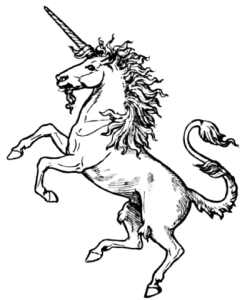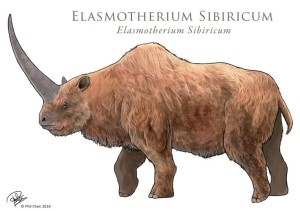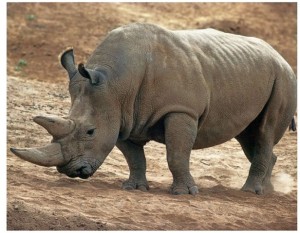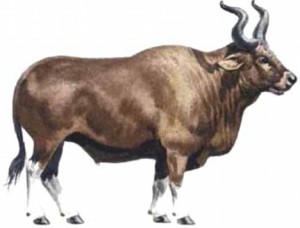Jun
13
Unicorns in the Bible? Not a Problem…
“God brought them out of Egypt; he hath as it were the strength of an unicorn.” — Numbers 23:22 (KJV)
This week, I decided to do a fun (but, it turned out, rather laborious) study on an issue that some Bible skeptics have used to mock or dismiss the reliability of God’s Word. You see, in nine different places in the Bible (Num. 23:22; 24:8; Deut. 33:17; Job 39:9,10; Psalms 22:21; 29:6; 92:10; Isaiah 34:7), it refers to unicorns. One could assume that the author and his original audience knew they were mythical and merely used it/them for literary effect. But, many (most?) readers now tend to read those passages as if they are referring to real creatures. Of course, “everybody” knows unicorns are fictional, which would be further evidence that the Bible is a bunch of myths and fables, right? Well,… that’s exactly what I want to investigate here.
 When most of us hear the word “unicorn”, we think of a creature that looks something like the one in this picture — a majestic, horselike creature, usually white, that has a long, straight(?) horn growing out of its forehead. Or, as it says in my copy of Webster’s New Collegiate Dictionary (1977),
When most of us hear the word “unicorn”, we think of a creature that looks something like the one in this picture — a majestic, horselike creature, usually white, that has a long, straight(?) horn growing out of its forehead. Or, as it says in my copy of Webster’s New Collegiate Dictionary (1977),
“a fabulous animal generally depicted with the body and head of a horse, the hind legs of a stag, the tail of a lion, and a single horn in the middle of the forehead”
Tales of these unicorns go back many hundreds of years. They are usually considered to be very intelligent (as quadrupeds go) and possessing mystical powers of some sort, either in life or death. Nowadays, they often show up in fantasy literature, TV shows, and movies, from Disney and C.S. Lewis to Blade Runner (director’s cut) and Harry Potter. But, they’re not real. Are they? Some people might try to defend the Bible’s reference to unicorns by positing that the legends were based on reality, that they are either very rare creatures who stay hidden and/or they existed in biblical times but are now extinct. As skeptics and anyone else familiar with zoology past and present will tell you, there have been no reliable sightings of these creatures in modern times, and there is no fossil evidence anywhere to substantiate that they lived in any era in Earth’s past. Of course, “absence of evidence is not evidence of absence”, and the stubborn proponent of this idea will probably stick with it. But, there are better explanations.
A second way to address this challenge is to look more closely at the word “unicorn”. Now, part of the issue lies with the particular Bible translation being quoted — usually, the ever-popular King James Version (KJV). Modern translations do not use “unicorn” in these verses, which I will get back to in a minute, but very early translations — e.g., Wycliffe Bible (1382), Bishops’ Bible (1568), Geneva Bible (1599), King James Version (1611; 1769), et al. — all say “unicorn”. So, in order to know what that word meant back then, we need to find a really old dictionary.
The first English dictionary, Robert Cawdrey’s A Table Alphabetical (1604), was rather limited (120 pages, 3000 words) and had no entries under “U”. Next best I could find was Nathan Bailey’s An Universal Etymological English Dictionary (1756), which has this entry: “UNICORN (of unus, one, and cornu, L. a horn) is by some supposed to be a very rare and beautiful beast, like an horse, having one long horn in the middle of the forehead twisted. But this creature not being well attested to have been seen, may well be thought to exist rather from its being mentioned in scripture; some persons suppose there must be such a creature….” What follows is mention of associated legends, as well as anecdotes of encounters with “unicorns” of varying size and description. The entry concludes, “It follows plainly, from all that hath been said, either that the generality of such accounts that mention unicorns must be false, or that travellers have blinded [sp?] and confounded several species of animal into one.” So, there was a bit of skepticism about the mystical horselike version back then, too, at least among some more educated folk. Very interesting…
The original edition of Noah Webster’s American Dictionary of the English Language (1828) has the following: “U’NICORN, n. [L. unicornis; unus, one, and cornu, horn.] 1. an animal with one horn; the monoceros. this name is often applied to the rhinoceros. 2. The sea unicorn is a fish of the whale kind, called narwal, remarkable for a horn growing out at his nose. 3. A fowl.” If one then looks up “rhinoceros” in the same volume, we see this: “RHINOC’EROS, n. [L. rhinoceros; Gr. nose-horn.] A genus of quadrupeds of two species, one of which, the unicorn, has a single horn growing almost erect from the nose. This animal when full grown, is said to be 12 feet in length. There is another species with two horns, the bicornis. They are natives of Asia and Africa.” So, we see that two types of rhinoceros were known to the British almost 200 years ago and possibly long before that, one with a single horn and one with two horns. (We now know of two extant single-horned species and three extant two-horned species.)
Modern rhino species are not native to anywhere near Ancient Palestine, with the closest being the now-endangered northern white rhino (see pic) of East and Central Africa south of the Sahara and the Indian rhinoceros, or greater one-horned rhinoceros, of the Indian subcontinent. There was, however, a lot of travel and trade with surrounding regions — including northeastern Africa — that the ancient Hebrews and their precursors (e.g., Job) could very well have been familiar with them, though rarely via personal encounter. Rhinos were likely the source of some ancient tales of one-horned beasts. However, this only seems like a possible — not probable — scenario for the biblical “unicorn”.
 For what it’s worth, there once was a genus of Eurasian rhinoceros, Elasmotherium, at least one species of which was the size of a mammoth and is informally known as the “Great Rhinoceros” or “Great (Siberian) Unicorn”. Current estimates are that it died out about 29,000 years ago; but, it’s not beyond the realm of possibility that a few survived into the time of the Biblical patriarchs. Some young-earth creationists (e.g., Ken Ham of Answers in Genesis) believe that this is indeed the animal God is describing in Job and that the other passages refer to. (Of course, Ham believes the Earth is only about 6000 years old, so Elasmotherium probably would have gone extinct about 3000 years ago.)
For what it’s worth, there once was a genus of Eurasian rhinoceros, Elasmotherium, at least one species of which was the size of a mammoth and is informally known as the “Great Rhinoceros” or “Great (Siberian) Unicorn”. Current estimates are that it died out about 29,000 years ago; but, it’s not beyond the realm of possibility that a few survived into the time of the Biblical patriarchs. Some young-earth creationists (e.g., Ken Ham of Answers in Genesis) believe that this is indeed the animal God is describing in Job and that the other passages refer to. (Of course, Ham believes the Earth is only about 6000 years old, so Elasmotherium probably would have gone extinct about 3000 years ago.)
So, why would the KJV (and its predecessors) use the word “unicorn”? Stick with me, as I need to get into the ancient languages a bit here…
First, a couple things about the King James Bible: 1) The Hebrew text used by the translators (i.e., the Masoretic Text) was sufficient for the task, but the translators’ understanding of Hebrew vocabulary was somewhat lacking. 2) The king instructed the translators to use the wording of the Bishops’ Bible whenever possible, unless a more accurate rendering could be found in either the Tyndale, Coverdale, Matthew/Rogers, Whitchurch/Cranmer, or Geneva Bible. These English translations were based either in whole or in part on Latin translations. It is interesting to note that the Latin Vulgate, completed by St. Jerome in AD 405, uses five different words in the verses in question, all variations on “rinoceros” and “unicornis”. The translators into Latin may have seen (con)textual clues that convinced them to use different words. I have read an explanation (by a layman) for why the one (supposedly referring to two-horned rhinos) is used in some places and the other (supposedly referring to one-horned rhinos) in other places, but I didn’t buy the argument.
When the early Latin translations of the Bible were done (2nd-5th cent.), Hebrew was even less favored and less known than Greek. There were also few Hebrew texts available by then. So, the translators often used, or at least consulted with, the Greek Old Testament. (Note: Even Jerome did several books of the Vulgate based on the Septuagint before switching over to Hebrew source texts.) It should also be noted that the Greek for the verses in question uses variations of “monokerotos” (i.e., one horn). This background about the Greek and Latin explains why the early English translations kept using “unicorn”, even though the Hebrew does not demand it.
Now, we get to the crux of it. Lest we forget, the Old Testament books were originally written in ancient Hebrew. So, rather than focusing on a particular English word, or even a Greek or Latin word, we should really check out the Hebrew word being translated ultimately as “unicorn”. The word is transliterated “rem” (or “reem” or “ram”) in the singular and “remim” (or “ramim”) in the plural. Truth is, even with better texts and superior Hebrew scholarship, current experts admit that they aren’t entirely sure what animal this is referring to. The early translators did their best, and it may indeed be some sort of rhino. However (and I could be wrong), I see no examples among the nine verses that demand the creature have only one horn. In fact, Psalms 92:10 is the only one that refers to a horn in the singular, and six of the verses don’t refer to horns at all. On the other hand, there is a pretty good argument that the horns of the animal in Deut. 33:17 are of different lengths, since they seem to represent the “ten thousands of Ephraim” and the mere “thousands of Manasseh”.
By the late 19th century, English Bible translators recognized that “unicorn” was misleading and began to use other words. For example, the Darby Bible (1890) used “buffalo”, the Douay–Rheims Bible (1899 Amer. ed.) used “rhinoceros”, and the American Standard Version (ASV) (1901) used “wild ox”. Most modern translations — e.g., CEB, GNT, ESV, HCSB, ISV, LEB, MEV, NABRE, NASB, NET, NIV, NKJV, NLT, NRSV, REB, RSV, TLV, WEB — opt for “wild ox(en)” or “wild bull(s)” in these verses. As I said, the exact meaning of the Hebrew word is unclear, but many believe it refers to the now-extinct great aurochs (Bos primigenius), aka urus. (Last recorded specimen died in Poland in AD 1627.) This “wild ox” was the ancestor of today’s domestic cattle, known for its size, strength, and long horns that were quite effective at goring.
So,… the third explanation is that the word “unicorn” was simply an ill-advised attempt at a translation way back when, from the Greek to the Latin and then into English. (Maybe it got into a few other non-English translations, too.) But, current scholarship, while not 100% sure, points to a creature a little less exotic and much more believable. This is no reason to doubt the credibility of Judeo-Christian Scripture.

















